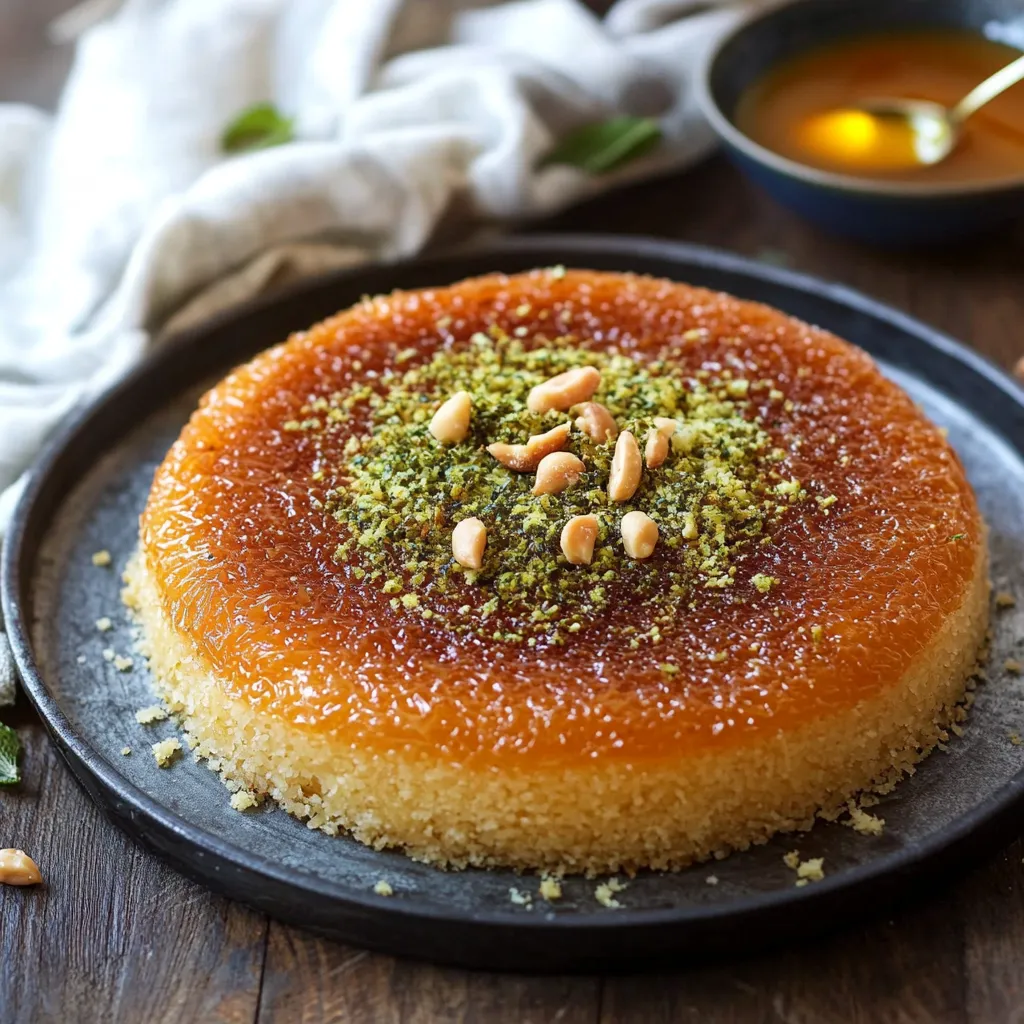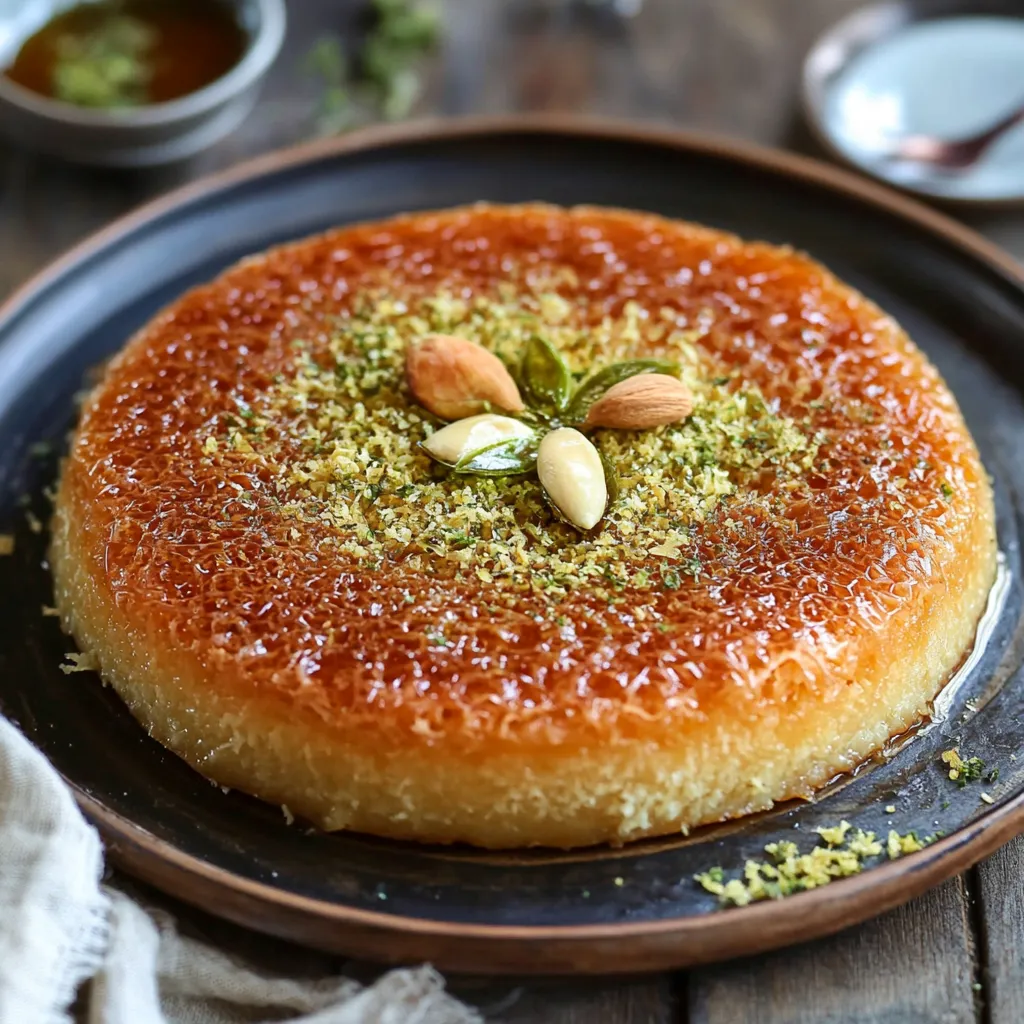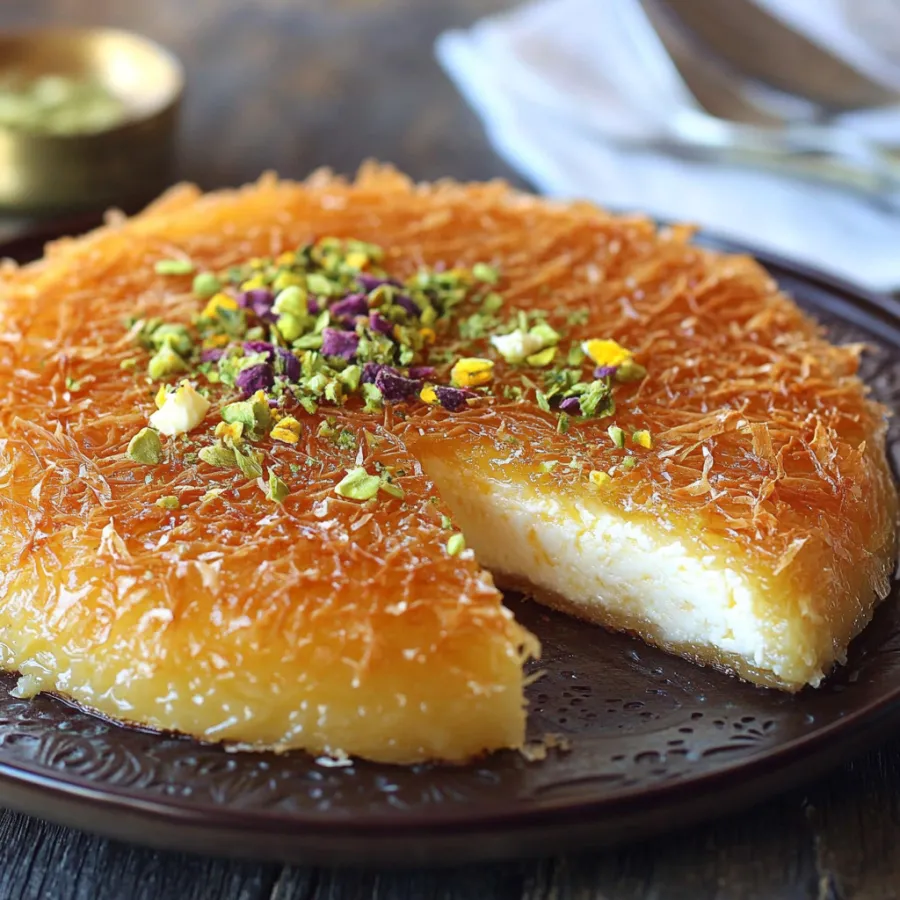 Pin it
Pin it
This traditional Middle Eastern dessert combines the crispy texture of shredded phyllo dough with a creamy vegan cheese filling, all soaked in fragrant orange blossom syrup. Perfect for special occasions or whenever you crave something uniquely sweet.
I first made this kunafa for Eid celebrations with my vegan friends, and even the traditional kunafa lovers couldn't tell the difference. The way the cashew-based filling mimics the stretchy texture of traditional cheese filling still amazes me every time.
Ingredients
- Kataifi shredded phyllo dough: Forms the signature crispy layers that give kunafa its distinctive texture
- Vegan butter: Creates richness and helps achieve that golden brown crust
- Cashews: Serve as the base for our vegan cheese filling, providing creaminess and subtle nutty flavor
- Tapioca starch: Crucial for creating that authentic stretchy cheese texture
- Orange blossom water: Adds the signature floral note that makes kunafa truly special
- Pistachios: Provide the classic finishing touch with color contrast and crunch
Step-by-Step Instructions
- Prepare the dough:
- Process the kataifi dough until properly shredded into small crumbly strands. This step ensures your kunafa will have the proper texture rather than clumpy sections. Thoroughly coat every strand with melted vegan butter using your hands to ensure even distribution and proper crisping during baking.
- Create the base layer:
- Pack half the buttered dough firmly into your baking dish, pressing some up the sides. This creates a sturdy base that will hold the filling and ensures even cooking. The more evenly you press, the better your final texture will be.
- Make the vegan cheese filling:
- Blend the cashew mixture until completely smooth with no graininess. When cooking the mixture, stir constantly to prevent burning. You will notice it changing from a liquid to a stretchy, unified mass. This transformation is critical and takes about 5 minutes of constant attention. The filling should pull like melted mozzarella when ready.
- Assemble and bake:
- Pour the hot cheese filling over the base layer and let it cool slightly before adding the top layer of dough. This cooling period helps prevent the top layer from sinking into the cheese. Press the top layer gently to create an even surface without compressing it too much. The baking process transforms the layers into a cohesive dessert with contrasting textures.
- Finish with syrup and garnish:
- Flip the kunafa carefully to showcase the more golden bottom crust as the presentation side. This traditional serving method highlights the beautiful caramelization. Apply the orange blossom syrup while the kunafa is still warm so it can absorb properly. Garnish with pistachios for the classic finishing touch.
 Pin it
Pin it
The orange blossom water is my absolute favorite ingredient in this recipe. I remember the first time I opened a bottle, the scent immediately transported me to the streets of Damascus where my grandmother would buy fresh kunafa from local bakers. That distinctive floral note is what makes this dessert truly authentic and unforgettable.
Storage and Reheating
Kunafa stores beautifully in the refrigerator for up to 3 days. Keep it covered to prevent it from drying out. The texture changes slightly when cold, becoming more firm and cheesecake-like. To return it to its original glory, reheat individual slices in the microwave for 30 seconds or place the entire kunafa covered with foil in a 300°F oven for about 15 minutes. Add a fresh drizzle of syrup after reheating to revive the moisture and sweetness.
Ingredient Substitutions
If orange blossom water is unavailable, rose water makes an excellent substitute though it gives a slightly different flavor profile that is equally authentic in many regions. Cannot find kataifi dough? Regular phyllo sheets can work in a pinch. Simply slice them into very thin strips with a sharp knife. For the filling, if you have nut allergies, silken tofu can replace cashews. Adjust the tapioca starch accordingly as tofu contains more moisture.
 Pin it
Pin it
Serving Suggestions
Serve kunafa warm for the best experience of contrasting textures. Traditional accompaniments include Turkish coffee or strong black tea to balance the sweetness. For an extra luxurious presentation, add a small scoop of vegan vanilla ice cream alongside each warm slice. The temperature contrast creates a delightful sensory experience. Some regions also serve kunafa with a sprinkle of cinnamon or a drizzle of agave syrup for those who enjoy a less sweet version.
Cultural Context
Kunafa originated in the Levant region but has spread throughout the Middle East with regional variations. In Palestine, it is often made with a distinctive orange color and is particularly famous in the city of Nablus. During Ramadan, kunafa becomes a staple dessert for breaking the fast. This vegan adaptation preserves the cultural significance while making it accessible to those following plant-based diets. The tradition of serving kunafa at celebrations symbolizes sweetness and prosperity in life.
Frequently Asked Questions
- → What is kunafa made of?
Kunafa is made with shredded phyllo dough, a sweet cheese filling, and it's soaked in orange blossom syrup. Pistachios are often used as a topping.
- → Can I prepare the dough in advance?
Yes, you can prepare the shredded phyllo dough mixed with melted vegan butter in advance and store it in an airtight container until ready to use.
- → What gives the kunafa its signature flavor?
The orange blossom syrup combined with the buttery phyllo strands and sweet cheese gives kunafa its distinctive flavor and aroma.
- → Is flipping the kunafa necessary?
Flipping the kunafa is optional but recommended for a more visually appealing presentation. It ensures the top of the dessert is crispy and golden-brown.
- → Can I substitute ingredients in the sweet cheese filling?
Yes, cashews can be replaced with other nuts like macadamia, but it may alter the texture slightly. It's best to experiment while maintaining the rich, creamy consistency.
- → How should I serve kunafa?
Kunafa is best served warm, with the orange blossom syrup drizzled on top. Additional syrup can be offered on the side for extra sweetness.
